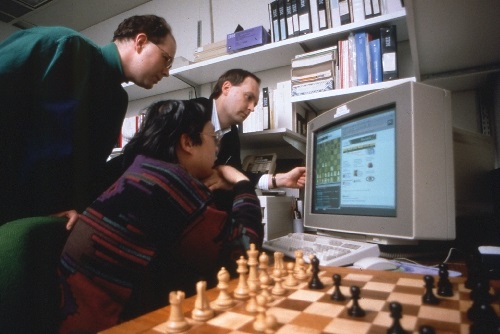

- Deep blue chess simulator software#
- Deep blue chess simulator professional#
- Deep blue chess simulator series#
- Deep blue chess simulator simulator#
When InSight arrived at the Red Planet in November, the communications time delay back to earth was about eight minutes. Take NASA’s latest Mars lander, InSight, which Lockheed Martin worked on. AI is already enabling incredible technology in deep-space travel.


That future isn’t all that inconceivable. Or, a world where self-flying drones can detect a forest fire at the outset, preventing it from ever destroying life or property. Imagine a world where self-flying drones immediately deploy to assess natural disaster zones – even those in the most remote areas – determining needs and deploying the right humanitarian supplies in near real-time. Autonomous flying technology promises to completely transform our approach to humanitarian aid, disaster relief and other situations that pose a potential threat to human safety but require quick and decisive action. The applications for self-flying drones obviously extend far beyond high-speed racing.

“I believe strongly that this challenge will tremendously accelerate the development of autonomy technology for agile robotic vehicles – those that will save lives via autonomous agile maneuvering at the time of a traffic accident, for example.”
Deep blue chess simulator software#
“Lockheed Martin and DRL are bringing together a diverse mix of experts and giving teams access to the right mix of hardware and software tools, plus dedicated virtual and real-life training opportunities to put their code to the test,” noted Professor Karaman.
Deep blue chess simulator simulator#
MIT Professor Sertac Karaman, whose team has been working on autonomous drone racing for the past few years and developed the simulator software being used to qualify AlphaPilot contestants, agrees, calling the challenge, “an incredible testing ground for game-changing autonomous drone technology.” It also blurs the line between the digital and the real, which will help AlphaPilot teams transition their tech from virtual testing environments to real-world deployments. DRL has been called the “sport of the future,” and it’s followed by tens of millions of drone heads, gamers and tech enthusiasts around the world. Why drone racing? It’s a great initial proving ground for AI innovation and self-flying drone technology.
Deep blue chess simulator series#
At the end of the AIRR season, the fastest autonomous drone will go head-to-head against the 2019 Allianz World Champion from DRL’s human-piloted drone series – a showdown of human vs.
Deep blue chess simulator professional#
Lockheed Martin, in partnership with The Drone Racing League (DRL), the global, professional circuit for drone racing, is inviting teams of students, coders and researchers to develop, test and then race high-speed, self-flying drones that require no human intervention or navigational pre-programming.ĪlphaPilot Teams will come together later this year to race their fully autonomous drones through complex, three-dimensional, video-game-inspired tracks in DRL’s new Artificial Intelligence Robotic Racing (AIRR) Circuit. human interaction – could be crossed later this year? What if I told you that threshold – the next “Deep Blue” moment in machine vs. However, while we’re starting to see some progress with AI-proof-of concepts in motorsports, ping pong and even basketball, AI has yet to come close to beating humans in real-life physical sports.ĭoing so will require a major technical leap from today’s state-of-the-art AI technology, advancing it to a place where AI can interact with, and make sense of, the physical world and unknown conditions, including physical contact from fellow racers or players – all while navigating a game strategy, race course, set of rules and other complex challenges. Today, artificial intelligence (AI) bots can defeat humans in not only chess, but nearly every digital game that exists. It was an historic moment, marking the end of an era where humans could defeat machines in complex strategy games. In 1997, IBM’s “Deep Blue” computer defeated grandmaster Gary Kasparov in a match of chess.


 0 kommentar(er)
0 kommentar(er)
